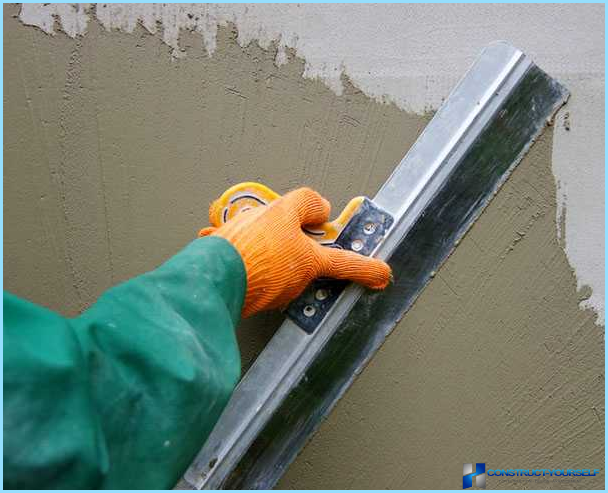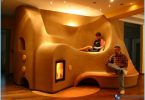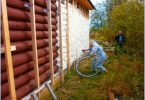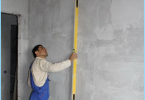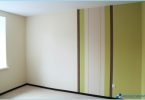The contents
- Progress plaster walls
- The use of new building technologies
- Small and large intensification technology
Admittedly, construction work is hard physical work that requires serious skills and attention to results of their work. Manual labor, still very expensive, private, and many things on the site are made by craftsmen in their own patterns and recipes. Production methods of construction often require to get rid of an individual’s handwriting manual, very expensive and different in the outcome of labor.
Progress plaster walls ↑
In addition to standardizing the results of the plaster walls, the use of advanced methods and technologies allows to dramatically increase productivity. Modern construction methods allow you to obtain a good speed of erection of walls of buildings, but finishing work is still largely dependent on manual labor. The real problem with the technology of plastering work arose with the emergence in the construction of high-rise buildings of load-bearing concrete frames and walls made of aerated concrete. Lightweight and durable blocks needed in a large number of plastering compositions.
To simplify the process advanced technology plaster walls offers the following methods:
- Mechanized methods of applying mixtures on the walls, their alignment with use of automatic machines for the control of surface quality;
- New construction and plaster mixtures;
- Reducing unproductive burden on the employee.
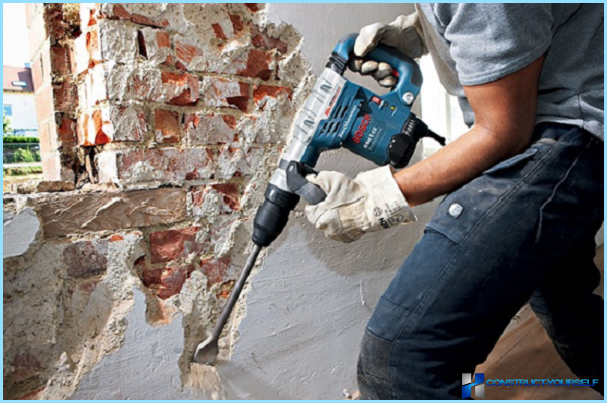
Thus, most building contractors have a vested interest in increasing the level of mechanisation of processes and increased productivity by new technology applying plaster.
The use of new building technologies ↑
Improved construction technology demanded high-speed application of plaster. Especially sensitive to the quality of applying the plaster was the wall of blocks of aerated concrete. The low weight and the possibility of automatic casting of entire wall sections of the future of masonry allowed us to build with great speed. An open porous surface structures of aerated concrete required compositions with improved texture and, most importantly, the technology of high-speed application of plaster, like concrete structures and walls made of aerated concrete.
Small and large intensification technology ↑
To small line improvements to operations related to the application of plaster on walls, involves the modernization and improvement of the method of preparation of the plaster mix. The list of small technologies include numerous devices, removes physical activity from a worker in the process of performing a simple unproductive operations: preparing the walls for plastering the surface and mixing of the components of the plaster material.
To systems with a high degree of mechanization includes machines that perform up to 70% of physically heavy work:
- Cleaning and even washing the concrete walls prior to application of the protective layer of plaster;
- Mixing the plaster in the required amount;
- The coating solution to the surface with a precisely dosed plaster mass consumption and effort fixing it on a vertical or even overhead surface.
Auxiliary machinery and equipment ↑
First to support new technologies in the plaster case steel automatic measuring of the geometry of the wall surface and mechanisms for the preparation of plasters. In the first case, ultrasonic equipment and sensors thickness of the superimposed layer is allowed without any beacons or landmarks masters confidently to align the draft layer, and even final layer of finishing the readings of the control plane. The rate of application of plaster for aerated concrete is increased, but still remained clearly insufficient.
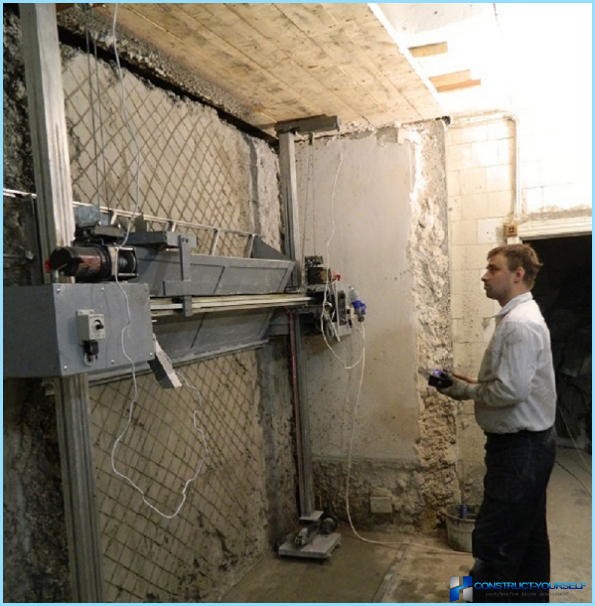
For high-rise apartment buildings with a large area of walls is more economically advantageous to prepare a solution of plaster, priming compound and coating compositions centrally, through a special blending plants great performance. As a concrete solution for the fill supporting structures, plaster mix was fed to the places of its use. The plaster on the wall has accelerated but not fundamentally changed the work of plasterers.
Advanced technology plaster walls ↑
Significant progress in the technology of laying of plaster on concrete walls and masonry of aerated concrete was the use of special installations for coating concrete and plaster mixes under pressure, giving superior adhesion of the solution with the wall surface.
Automated application of paint primer ↑
First of all, technology automation helps to simplify the preparatory work associated with cleaning and application of primer on the surface of the concrete walls, brickwork and aerated concrete blocks. Before applying the base sprayed wall surface is blown with high pressure air. The smallest dust and mist is collected by the dust collector. It gives you superior quality cleaning of pores on the surface of the usual concrete and brick. Immediately before applying the plaster to the wall sprayed with the primer solution. This method gives a much improved preparation of the wall, especially for walls made of aerated concrete.
For example, in a private low-rise building increasingly as material for house walls use blocks of aerated concrete or arbolita. The advantage of the lining – improved insulation, but, unlike concrete structures, requires the application of plaster, with an area of several hundred square meters. To manually perform such scope of work without the technology of mechanization of the process is very difficult and physically painful.
The advantage of this technology machine application of mortar plaster include the following:
- High performance coating mortar plaster, regardless of the conditions of work;
- The uniformity of composition of plaster over the entire area of the walls;
- More than twice increased adhesion of mortar from the concrete and aerated concrete surfaces due to the dynamic impact of the jet of material on the wall.
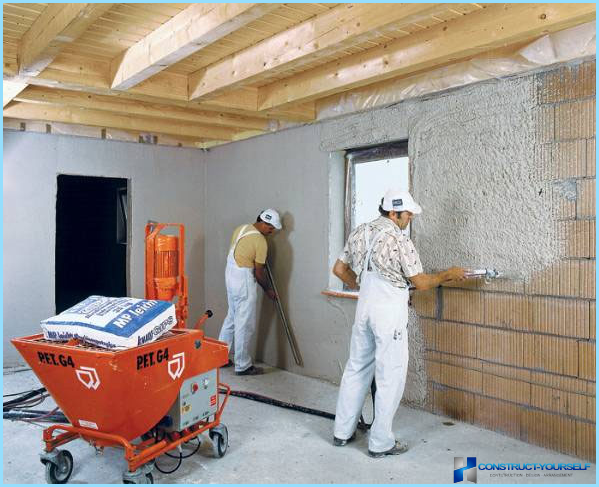
The layer of plaster is formed in a single session, so there is no need stratified application of the solution with intermediate drying, whereby the total time of plastering work is reduced from two-three days to one day.
The use of technology in the plaster walls of new materials ↑
New technology finishing touched not only the way of cooking, drawing or alignment of the mass and receiving of plaster with improved mechanical properties. Such mechanization is quite widely used in major construction projects, the cost of using the rental of such equipment is available even in the private economy.
More exotic in construction are new materials with improved strength, thermal insulation and decorative features.
Most often this applies to new fibre fillers of ultra-slim polymer and glass fibers used for reinforcement and compaction. The diameter of these fibers is comparable with the size of the cement particles, so the mixture material is obtained with improved thermal insulation and durability.
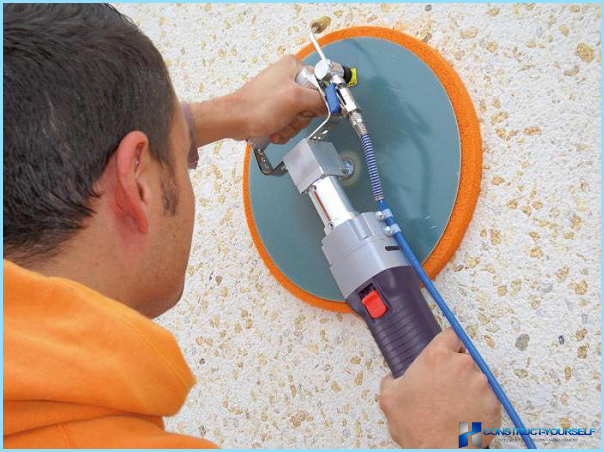
The second direction of development of technology of plaster walls is the use of a mixture of special organic additives, actively displacing the air between the cement particles. Thanks to this concrete casting becomes more than 60% improved Flexural strength and resistance to alternating loads.
The third direction has already been quite popular in the field of decorative and finishing plasters is the complete or partial replacement of the cement binder, an organic epoxy or polyester material.
In the sale of such material is already known as microcement. It is composed of separate components in the form of liquid resin, powder filler, a special solution to prepare the primer. Before applying the plaster, the wall is cleaned and primed with diluted epoxy resin. After displacement of air bubbles from the layer of special primer smoothing tool on the wall is applied to cooked the main batch of plaster to the alignment layer thickness. After 30-40min material layer can be aligned using a regular metal spatula.
It should be noted that the cost of such plaster is significantly higher than conventional plastering compositions, so it is most often used as a bond coat for trim and decorative textures from the marble or calcite chips.
Conclusion ↑
Technology plastering the walls is dynamically developing in the field of mechanization of methods of applying the solutions, and the use of materials with new properties. But it is unlikely that new technology will make mechanized finishing work cheaper than the traditional manual method.

